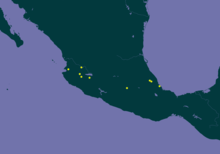| Amanita yema | |
|---|---|

| |
| Scientific classification | |
| Domain: | Eukaryota |
| Kingdom: | Fungi |
| Division: | Basidiomycota |
| Class: | Agaricomycetes |
| Order: | Agaricales |
| Family: | Amanitaceae |
| Genus: | Amanita |
| Subgenus: | A. subg. Amanita |
| Section: | A. sect. Caesareae |
| Species group: | caesarea |
| Species: | A. yema
|
| Binomial name | |
| Amanita yema Guzmán & Ram.-Guill.
| |

| |
| Synonyms[1] | |
| |
Amanita yema is a species of fungus in the genus Amanita, family Amanitaceae.[1] The fungi can be identified by its pileus[2] color of a red center that gradually fades into a yellow-hued edge. Growing only in forest outskirts in Mexico,[3] the fungus is a critical member of the plant biome as it is a mycorrhizal fungi.[4]
Taxonomy[edit]
Amanita yema was identified as a species of fungus in 2001 by Guzmán & Ram.-Guill.[5] It was soon categorized under the taxa: Amanita caesarea complex[3]
Description[edit]
Standing tall with a pileus that fades from a red center to a yellow margin, this fungus stands out. With a base that ranges from a white/yellow color to an orange colored stem. Its gills, or lamelle, is also described to have a white or yellow tint.[2] Stemming out of the soil, the fungus is often found around forest edges in Mexico. The fungus is said to have a mild odor and taste,[1] but is pleasantly enjoyed.
Habitat and distribution[edit]
This mushroom is found in most temperate forests in Mexico[6] and is locally used[4] by its natives. It strives with being locally in demand, be that in the rural areas' markets or in major cities. There is a demand for this fungus in Italy, but no trade has been made with Mexico. [6] As part of the Amanita caesarea complex, it is deemed to have a high cultural significance[7] in Ixtlan.
Edibility[edit]
This mushroom is deemed to be wild edible[3] fungus, and are said to have a pleasant taste. It is almost always consumed with other mushrooms and meat. Although with its simplicity and rather small size, many eat the mushroom by its self. With a simple light washing with water[8] it is ready to be cooked. It is however, a species of fungi that is avoided, as it is similar in appearance to the toxic fungal specie Amanita muscaria. [4] Its local abundance is low,[4] which increases its worth both locally and globally.
Medicinal uses[edit]
Among the Amanita caesarea complex, A. yema is in high demand for its medicinal uses. It is frequently prepared as an anti-inflammatory[9] agent. There are other treatments the mushroom can be used for. Acting as a gastrointestinal treatment, the mushroom is boiled and its cooking water is consumed at room temperature, for renal problems.[10]
References[edit]
- ^ a b c "Amanita yema". www.amanitaceae.org. Retrieved 2022-05-08.
- ^ a b Tulloss, R. (2009). "Notes on Amanita section Caesareae, Torrendia, and Amarrendia (Agaricales, Amanitaceae) with provisional division into stirpes and annotated world key to species of the section". S2CID 53058804.
{{cite journal}}: Cite journal requires|journal=(help) - ^ a b c Garibay-Orijel, R.; Cifuentes, J.; Estrada-Torres, A. (2006). "People using macro-fungal diversity in Oaxaca, Mexico". S2CID 54756404.
{{cite journal}}: Cite journal requires|journal=(help) - ^ a b c d Garibay-Orijel, Roberto; Córdova, Juan; Cifuentes, Joaquín; Valenzuela, Ricardo; Estrada-Torres, Arturo; Kong, Alejandro (2009). "Integrating wild mushrooms use into a model of sustainable management for indigenous community forests". Forest Ecology and Management. 258 (2): 122–131. doi:10.1016/j.foreco.2009.03.051. ISSN 0378-1127.
- ^ "Amanita tecomate". Global Biodiversity Information Facility. Retrieved 2022-05-07.
- ^ a b Wild product governance : finding policies that work for non-timber forest products. Sarah A. Laird, Rebecca J. McLain, Rachel Wynberg. London: Earthscan. 2010. ISBN 978-1-84977-519-9. OCLC 659560965.
{{cite book}}: CS1 maint: others (link) - ^ Garibay-Orijel, Roberto; Caballero, Javier; Estrada-Torres, Arturo; Cifuentes, Joaquín (2007-01-11). "Understanding cultural significance, the edible mushrooms case". Journal of Ethnobiology and Ethnomedicine. 3 (1): 4. doi:10.1186/1746-4269-3-4. ISSN 1746-4269. PMC 1779767. PMID 17217539.
- ^ Carrera, D.; Sobal, M.; Aguilar, A.; Navarro, M.; Bonilla, M.; Saavedra, A. L. (1998). "Canning technology as an alternative for management and conservation of wild edible mushrooms in Mexico". S2CID 106394674.
{{cite journal}}: Cite journal requires|journal=(help) - ^ Guzman, Gaston (2008). "Diversity and Use of Traditional Mexican Medicinal Fungi. A Review". International Journal of Medicinal Mushrooms. 10 (3): 209–217. doi:10.1615/intjmedmushr.v10.i3.20. ISSN 1521-9437.
- ^ Sánchez-García, D.; Burrola-Aguilar, C.; Zepeda-Gómez, C.; Estrada-Zúñiga, M.E. (2020-11-15). "Edible, medicinal wild mushrooms: A study in Estado de México". Agro Productividad. 13 (10). doi:10.32854/agrop.v13i10.1746. ISSN 2594-0252. S2CID 228845026.
